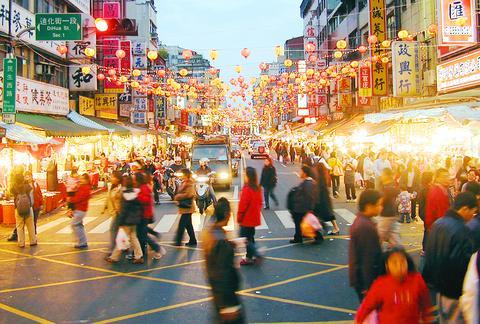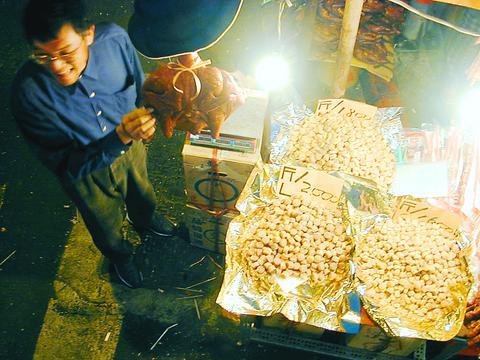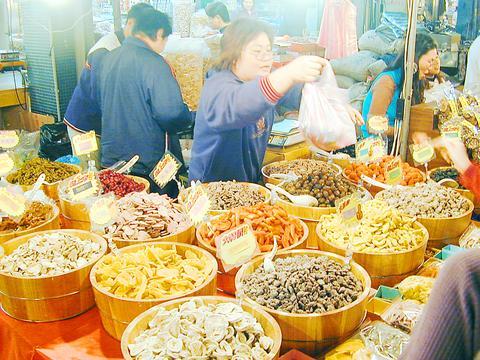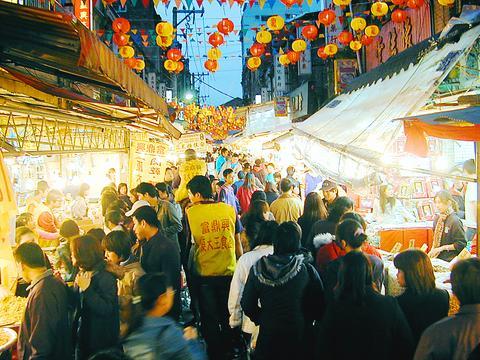The number of oddities and essentials sold along Dihua Street throughout the year is a smorgasbord for the senses. In the weeks before the Lunar New Year, however, the 150-year-old trading post becomes a veritable circus. There is seemingly no end to the number of dried, candied and pickled things available to holiday shoppers.
To better understand Chinese culture, you can do no better than walk down Dihua Street. And with only five days left before the year of the monkey, there's little time left to horse around.
The area began to boom in the 1850s after a trader named Lin Lan-tien set up shop on the street. He traded locally produced sugar, rice, camphor and fruit with merchants importing goods from China, then sold their products to locals. Textiles became the area's main item of trade and remains so today, but there are over a hundred shops in the area selling traditional medicines, some of which have been open since the late 1800s.

PHOTO: DAVID MOMPHARD, TAIPEI TIMES
But despite the fact that many of the area's vendors now ply a trade in fabric or medicine, the economic importance of Lunar New Year cannot be overestimated.
"Half of what I make each year is in January," said one shopkeeper named Gao. For the past three weeks he's sat atop a small mountain of dried fish, but normally Gao's shop is lined with bolts of cloth. Like many vendors here, he's moved aside his usual inventory to sell the trappings of Chinese New Year.
"I trade this stuff year round," he says of his variety of dried, shredded fish, "but nobody comes to this part of town during the year to buy it. So it goes straight from where it's made to store shelves."

PHOTO: DAVID MOMPHARD, TAIPEI TIMES
He's not alone in his new year's sales estimate. Most merchants will tell you that about half of their yearly earnings are made in the weeks leading up to the new year -- if, that is, you can catch them at a moment when they're not hawking customers.
Foodstuffs aren't the only thing being flogged. Lunar New Year decorations, jade trinkets and calligraphy are also on offer, as are such practical things as socks, slippers and speeding detectors.
But if you're thinking there are bargains to be had on these things -- or on the foodstuffs -- think again. Mark-ups are typical and often extreme (though this is usually part of the sales pitch -- there are no set prices here). A box of Chinese tea I bought from a local vendor last fall cost NT$300 at the time. That same box from the same vendor cost NT$1,000, but he was willing to let me have three boxes for that price.

PHOTO: DAVID MOMPHARD, TAIPEI TIMES
Anyone heading towards Dihua Street is strongly recommended to leave their car at home and take public transportation, as there is virtually no parking available on any of the streets in the vicinity. A driver's best bet is to head for the large parking area adjacent to the Tamshui River at the end of Minsheng East Road. Note, however, that driving on Minsheng Road becomes more congested as you approach Dihua Street. It is a 15-minute walk east down Minsheng East Road from the Shuanglien MRT station. Special busses running the length of Minsheng East Road will also be available during the next two weeks. Look for the busses marked with red and white banners.

PHOTO: DAVID MOMPHARD, TAIPEI TIMES

PHOTO: DAVID MOMPHARD, TAIPEI TIMES

June 23 to June 29 After capturing the walled city of Hsinchu on June 22, 1895, the Japanese hoped to quickly push south and seize control of Taiwan’s entire west coast — but their advance was stalled for more than a month. Not only did local Hakka fighters continue to cause them headaches, resistance forces even attempted to retake the city three times. “We had planned to occupy Anping (Tainan) and Takao (Kaohsiung) as soon as possible, but ever since we took Hsinchu, nearby bandits proclaiming to be ‘righteous people’ (義民) have been destroying train tracks and electrical cables, and gathering in villages

Dr. Y. Tony Yang, Associate Dean of Health Policy and Population Science at George Washington University, argued last week in a piece for the Taipei Times about former president Ma Ying-jeou (馬英九) leading a student delegation to the People’s Republic of China (PRC) that, “The real question is not whether Ma’s visit helps or hurts Taiwan — it is why Taiwan lacks a sophisticated, multi-track approach to one of the most complex geopolitical relationships in the world” (“Ma’s Visit, DPP’s Blind Spot,” June 18, page 8). Yang contends that the Democratic Progressive Party (DPP) has a blind spot: “By treating any

Swooping low over the banks of a Nile River tributary, an aid flight run by retired American military officers released a stream of food-stuffed sacks over a town emptied by fighting in South Sudan, a country wracked by conflict. Last week’s air drop was the latest in a controversial development — private contracting firms led by former US intelligence officers and military veterans delivering aid to some of the world’s deadliest conflict zones, in operations organized with governments that are combatants in the conflicts. The moves are roiling the global aid community, which warns of a more militarized, politicized and profit-seeking trend

This year will go down in the history books. Taiwan faces enormous turmoil and uncertainty in the coming months. Which political parties are in a good position to handle big changes? All of the main parties are beset with challenges. Taking stock, this column examined the Taiwan People’s Party (TPP) (“Huang Kuo-chang’s choking the life out of the TPP,” May 28, page 12), the Democratic Progressive Party (DPP) (“Challenges amid choppy waters for the DPP,” June 14, page 12) and the Chinese Nationalist Party (KMT) (“KMT struggles to seize opportunities as ‘interesting times’ loom,” June 20, page 11). Times like these can